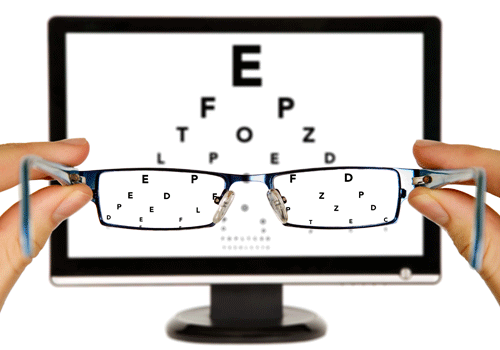Today is the time of technology and almost 99 percent of the work in offices is done by using computers. This has given a rise to a lot of computer related eye strain complaints. According to studies, around 50-90 percent of people working on computers face eye strain and other troublesome visual signs. Decreased productivity, physical tiredness, red eyes, eye twitching, increase in work errors are some such problems.

Here is a list of 10 steps so that you can reduce eye strain and other similar troubles:
1. Get a complete eye check-up done
It is very important to get complete eye check-up done in order to avoid any kind of computer vision problems or treat them, if any. Experts say that if you are a computer worker, you must get your eyes checked at least one a year.
At the time of the check-up, inform your eye doctor about how often you work with the computer on a daily basis. Also measure the distance between your computer and your eyes, informing him about the same. He would also inform you about the correct working distance.
2. Get a display upgrade
It is necessary that you should the old tube-style monitor and replace it is a flat-panel liquid crystal display, which is seen in laptops also. LCD screens have an anti-reflective surface and thus are better for the eyes. Screens on old computers lead to flickering of image that is one of the major reasons of strain on the eyes and fatigue. In old-fashioned computers, you can also adjust the display settings and bring them to the highest possible refresh rate.
When you are buying a flat panel display, opt for such a screen that has the highest resolution possible with lower dot pitch so that images appear sharper. You can select a screen that has a dot pitch of .28 mm or even smaller. Moreover, LCD screens do not have flicker issues. Go for a large display with screen size of at least 19 inches.
3. Proper lighting is important
There is strain on one’s eyes due to excessive bright light that might be from strong indoor lighting or from the sunlight coming in from the window. While using computers, it is important that the lighting surroundings you should be around half as bright as is seen in most of the offices. Use fluorescent tubes or bulbs with lower intensity and avoid all exterior light using curtains. If possible, windows should not be in front of behind but on the side of the screen.
It has been seen that most of the people working on computers preferred halogen or indirect lighting instead of overhead fluorescent lights. Thus, you can remove some of the overhead light, if they are bothering you.
4. Reduce the surrounding glare
Finished surfaces, reflections on the computer screen and glare on the walls can lead to strain on eyes to the computers. Instead of bright white walls, you can paint your wall in a darker tone that has a matte finish. You can also install an anti-glare screen on your computer monitor or can use a computer hood for light coming from outside.
If you wear spectacles, you can buy lenses that have anti-reflective (AR) coating as this diminishes the amount of light reflecting off the back and front surfaces from the lenses of your glasses.
5. Adjust the display settings of your computer
By adjusting the display setting of your computer, you can reduce the strain on your eyes considerably and not feel tired too. Make changes in these:
- Text size and contrast– While composing or reading long documents, you can adjust the contrast or the size of the text. In most of the cases, black letter on a white background is the most comfortable combination.
- Brightness– Adjust the brightness of your display in same manner as is the brightness of your work station. Have a look the page- if it looks dull, it might be dark and if it look like a source of light, it might be too bright.
- Color temperature– You can reduce the color temperature of your computer screen by bringing down the blue light being emitted from the colorful display as it is harmful for the eyes. By reducing the blue light, you will make long-term viewing comfortable.
6. Change your work desk
If your job involves looking back and forth from the screen of your computer to a printed page, it can really strain your eyes. It is advisable that you keep the page, adjacent to your screen, and there should be ample light on the page. You can use a desk lamp but its light should not fall straight on the monitor or your eyes.
Incorrect posture while using computer is another reason for computer vision syndrome. Your chair and work desk must be at the ideal height. Buy ergonomic furniture so that the screen of your computer is 20 to 24 inches from your eyes. The screen’s center must be 10 – 15 degrees below your eyes so that your neck and head are in a comfortable position.
7. Blink more frequently
While you are working on a computer, blinking more often is important as it moistens the eyes so that there is no irritation and dryness. As per studies, people blink less when they are working on a computer, around one-third of what they normally do. Many others are only into partially closing their eyelids, which must not be done.
When we do not blink regularly, the tears which coat our eyes evaporate quickly, causing dryness in the eyes. The environment of the office is also dry, putting our eyes at a larger risk of dry eyes. In case you think you are having dry eye problems, you can ask the eye doctor about using artificial tears.
You can try an easy exercise for reducing the problem of dry eyes while working on a computer. After every 20 minutes, blink your eyes 10 times, closing them slowly as if falling asleep. This is going to bring moisture in your eyes.
8. Take breaks often
To save your back, neck and shoulder from pain and not risking your eyes with computer vision syndrome, it is recommended that you must take frequent breaks while working on a computer. A study says that along with at least two 15-minute breaks, one must take at least four five-minute breakfast during the day at work.
There is no need to worry as these mini breaks in no-way are going to hamper your productivity. According to a study, the productivity actually increased after this. During breaks, you can stretch your neck, legs, arms, shoulders and back to
During your computer breaks, stand up, move about and stretch your arms, legs, back, neck and shoulders to reduce tension and muscle fatigue.
Check your local bookstore or consult your fitness club for suggestions on developing a quick sequence of exercises you can perform during your breaks and after work to reduce tension in your arms, neck, shoulders and back.
9. Opt for computer eyewear
You can get a customized eyewear made for yourself that you can especially wear while working on computers. Such glasses can also be worn if you are wearing contact lenses, be it progressive or bifocal lenses. This will also protect your eyes against dryness.
10. Exercise your eyes
Continuous focusing on the screen can lead to fatigue and tired eyes. To save your eyes from getting tired, do not keep looking at the computer screen for long. Look away from it after every 20 minutes. Set your eyes at an object that is at least 20 feet away. Do this for at least 20 seconds. This is known as the ‘20-20-20 rule’. As we look far away and focus on an object, the muscles of our eyes feel relaxed.
There is one more exercise. Look at a faraway object for 10 to 15 minutes and then look up for the same duration and then again look at the faraway object. This must be done at least 10 times in a day. By doing this, you can improve your focusing ability while working on computer for long hours. Do these exercises for reducing the risk of computer eye strain.
[ Find an affordable Eye Treatments in India ]
Related posts:
What Eye Problems look Like
Facts about Retinal Detachment
6 Easy Tips for Healthy Eyes
Conjunctivitis (Pink Eye): Cause, Symptoms and Treatments
